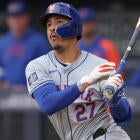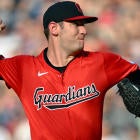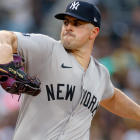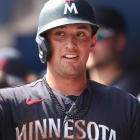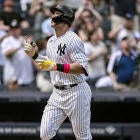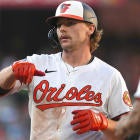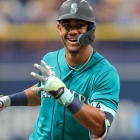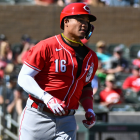1. Will Hanley Ramirez come back down to earth?
In 2013, Hanley Ramirez hit .345 with 20 home runs, 10 steals and 25 doubles ... in just 304 at-bats. These numbers weren't exactly new to Ramirez -- he hit .342 in 2009 (and holds a lifetime .302 average) and he's hit 20-plus homers six times in his career. His 2011 and 2012 campaigns were injury-riddled messes, but we did see him begin to pull through after the trade to the Dodgers in 2012, hitting .271 with 10 home runs in the 64 games following the deal. And 2013 is significant because it was injury-riddled, but Ramirez was awesome. Ramirez is capable of hitting .340 with 30 home runs, but it's far more likely we see .320 with 25. Throw in 20-25 steals at a very weak position (Fantasy-wise), and sure -- Ramirez will be coming back down to earth, but he'll still be out in orbit somewhere with those numbers.
2. How do the Dodgers fit four outfielders into three spots?
I subscribe to the theory that things have ways of working out, usually through timely injuries. But if this doesn't happen, the Dodgers are going to have to deal with the possibility of having four very good outfielders -- Matt Kemp, Carl Crawford, Yasiel Puig and Andre Ethier -- with only three spots in which to play them. The most likely scenario -- turning Ethier into a bench player once Kemp returns from the DL -- isn't really maximizing his value. Either is a solid defender who can play all three outfield spots, and he has a .288 lifetime average, with more career doubles (264) than Ryan Braun or Joey Votto and more home runs (141) than Adam Lind or Carlos Gonzalez. As Kemp comes back, he will probably yield a game or two a week to Ethier, but Kemp averaged 159 games played from 2008 to 2011 -- he'll eventually settle back into an everyday player groove. Maybe Crawford sits here or there to get Ethier into the lineup, but the Dodgers would probably be better served dealing Ethier and relying on Scott Van Slyke as the backup outfielder until Joc Pederson is ready. Until something like that happens, though, it appears Ethier (and maybe Crawford) will see the biggest dip in value.
3. Does the risk justify the reward with Billy Hamilton?
Vince Coleman stole 100-plus bases twice in the minor leagues. He finished his career on the farm with a .283 batting average and .358 OBP. Billy Hamilton stole 100-plus bases twice in the minor leagues. He finished his career on the farm with a .280 batting average and .350 OBP. Coleman then went on to steal 100-plus bases in his first three seasons, averaging 107 runs scored in that span, while hitting just .263. The major worry with Hamilton is that he won't be able to hit, and will therefore not get those 80 steals everyone is depending on. But Coleman hit just .267 (with a .320 OBP) his rookie year and stole 110. Even if Hamilton wallows in the .240 area, we could still see 80-plus steals from him. And in a Roto league, that's a risk worth taking, especially if you've built a team based on power up to that point.
4. Who can you trust in the Rangers, White Sox and Diamondbacks bullpens?
These three bullpens are going to require a good amount of lucky guessing. Joakim Soria is the closer in Texas. Rangers manager Ron Washington made some comments about Feliz' drop in velocity recently, telling reporters that, "it's going to be a while until we get to the point where he can freely let it go."
The White Sox traded their closer, Addison Reed, to the Diamondbacks in the offseason. It left Nate Jones -- a hard-throwing 28-year old with a career 3.31 ERA and 1.30 WHIP -- as the favorite to close. However, Matt Lindstrom has saved 45 games in his career; and once he gets past a strained oblique, he could find himself in the mix for saves. For now, Jones looks to be the favorite. But if another Hector Santiago situation pops up -- he had an 8.53 ERA through the end of April after being named the team's closer in 2012, eventually giving way to Reed -- Lindstrom could swoop in.
Arizona's situation comes down to Reed and J.J. Putz. The team traded away top prospect Matt Davidson for Reed, so there may be some pressure to use their new asset. But Kirk Gibson seems to be the kind of manager who would install the veteran Putz -- and his 189 career saves, including 77 between 2011 and 2012 -- as the closer. Putz has a 2.56 ERA and 1.04 WHIP, with a 10.3 K/9 over the last four seasons. He may be far better than Fantasy players give him credit for.
5. So we know about Ryan Braun, but how should we approach those other players returning from Biogenesis suspensions?
Nelson Cruz's late signing pushed his ADP down far enough to the point where he may be somewhat of a bargain. That's essentially the only positive I have for those players. If you look at the leaked records indicating what Alex Rodriguez was doing on his Biogenesis regimen, it included oral shots of testosterone before games (the infamous gummy bears) -- kind of like an undetectable modern day greenie. These players aren't going to have that boost and focus before games this season (assuming they were on a similar regimen, which -- based on the spotty information and reluctance of the players to talk -- is all we have to go on). Additionally, we haven't seen what influence PED usage has on speed. Everth Cabrera's main Fantasy asset is his ability to run, and if he's suddenly losing leg strength (on top of losing the daily game boost and general muscle mass), he's going to lose speed. Jhonny Peralta -- a career .268 hitter who has sported an OPS above .705 just twice since 2009 -- is a decent bet to drop off, Bartolo Colon should hit that age wall at some point (although the move to the NL could offset some of that), and the rest of the Biogenesis players remain just below the line of Fantasy relevance.
6. Is Masahiro Tanaka an ace in the hole?
Masahiro Tanaka's ERA didn't go above 1.87 in any of the last three seasons (in Japan). His WHIP was below 1.00 in two of those. His K/9 has only been above 8.9 twice over seven years, but that may not be a big issue if he manages to keep his ERA and WHIP very low. The Yankees broke their budget to sign Tanaka, and this is a team that insisted for a solid two years that they wouldn't move above the $189 million level. To do that -- and to commit that long -- requires a ton of faith in Tanaka's skills. Yu Darvish had better numbers in Japan -- sustaining a lower ERA and WHIP over a longer period of time, and striking out more batters -- but Tanaka's last three seasons are comparable, with just a slightly lower strikeout rate. And with Darvish considered a top three Fantasy pitching option, Tanaka may prove to be top 10 by the time the dust settles on the season, especially with the early advantage of not having been throughly scouted by most teams.
7. Better grab a second baseman early, right?
Not exactly. Jedd Gyorko has breakout potential and he can be had in the eighth round. Go a little deeper and you have Anthony Rendon, Jed Lowrie, Nick Franklin and even better-than-you-may-think options in Omar Infante and Dustin Ackley. The Brewers' second basemen (Rickie Weeks and Scooter Gennett) could produce one good option, assuming a winner emerges soon, and people seem to forget that DJ LeMahieu hit .280 with 18 steals and 21 doubles over 109 games last year (after hitting .321 over five minor league seasons). There is serious depth at second base. How deep it goes depends on things like your faith in Brian Roberts staying healthy -- but the upside exists. There's no need to panic on second base this season -- it gently cascades, as opposed to violently dropping off.
8. Will everyday at-bats make all the difference for Jurickson Profar?
Oh, what could have been. Jurickson Profar was the top prospect in baseball heading into the 2013 season. Called up in late May, he hit .234 with six home runs and two steals over 286 at-bats. But Profar ended up playing five different positions (shortstop, third base, left field and DH) in an effort to get his bat in the lineup. There were just two stretches last season when Profar played in five or more consecutive games at the same position, and the 21-year-old saw his stats suffer for it. The regular at-bats in 2014 should have allowed Profar to get into a groove at the plate, but that's just not going to happen now. Not after suffering a shoulder injury that could keep him out of the lineup for half the season. If your league allows you to stash players in DL spots, he's still worth drafting and holding onto for a potential second-half boost. Profar is young and inexperienced, and the normal learning curve of the major leagues was likely steepened by him having to learn new positions and adjust to the intermittent playing time last season.
9. Is this the year Bryce Harper explodes?
Bryce Harper ran into a wall at Dodger Stadium on May 13 last year. He was hitting .303 at the time with 10 home runs, six doubles and a 1.022 OPS. He's spoken this spring about how he should have undergone surgery to address a knee injury instead of trying to play through it. He's also added weight in the offseason, has a stellar lineup surrounding him and went through an intense offseason conditioning program. Now pile all of this on to his seemingly limitless potential. Harper was on pace for 50 home runs last season. His .303 average through May 13 was accompanied by a league normal BABIP (.299). And we've probably seen just the start of some very real speed potential. Harper's current ADP has him going in the middle of the second round in most drafts. He may head into 2015 as a consensus top five Fantasy option.
10. How much faith do you put in the young guns with only half a year's experience, such as Michael Wacha, Gerrit Cole, Tony Cingrani, Sonny Gray and Danny Salazar?
It's tough to throw a blanket on this group, because they all have something different to offer. Wacha, Cole and Cingrani are high-strikeout (Cole eventually came around, with a 9.3 K/9 in his last 11 starts, coming off a 5.4 K/9 over the first eight), low ratio assets without much of an injury history. Salazar has that type of potential, but has battled arm issues in the past and comes with that stigma. Gray elevated his game in 2013 at the major league level, but has a spotty track record in the minors, with fluctuating strikeout rates (it went from 8.2 to 5.9 up to 9.0 in the last three seasons) and relatively high ratios (3.66 ERA and 1.36 WHIP over three years). Still, Gray had excellent control in 64 major league innings and struck out over a batter per inning (at age 23). Despite not having the greatest minor league numbers, he may turn out to be Alex Cobb-ish in his consistency and ratios.
Youth and inexperience shouldn't factor in much here. Wacha, Cingrani, Cole and Gray all pitched in college, while Salazar spent seven seasons in the minors. They've proven they can pitch at the major league level and can be relied on (to varying degrees) as 2014 Fantasy assets.
Stay in touch with the most passionate Fantasy staff in the business by following us on Twitter @CBSFantasyBB







